Tue 20 May 2014
A Movie Review by Jonathan Lewis: THE LINEUP (1958).
Posted by Steve under Crime Films , Reviews[10] Comments
THE LINEUP. Columbia Pictures, 1958. Eli Wallach, Robert Keith, Richard Jaeckel, Mary LaRoche, William Leslie, Emile Meyer, Marshall Reed, Raymond Bailey, Vaughn Taylor, Warner Anderson. Screenplay: Stirling Silliphant. Director: Don Siegel.
The Lineup is a visually captivating thriller set in the historic buildings and on the daytime streets and roadways of San Francisco. It stars Eli Wallach (The Good, The Bad, and The Ugly), in one of his earliest big screen roles, as a Brooklyn-accented sociopathic hired gun for an international heroin smuggling operation.
Directed by Don Siegel (Dirty Harry), The Lineup is best interpreted as two distinct films wrapped together in one package. Indeed, the film, based on both a CBS radio show (1950-1953) and television show (1954-1960) of the same name, is two movies in one: a formulaic, somewhat forgettable, police procedural and a very good, albeit under-appreciated, film noir. It’s the story of a disturbingly violent, and somewhat pathetic, criminal on the margins of polite society, a man whose own unbridled rage propels him to his inevitable doom.
The film begins as a standard police procedural, opening with a fast-paced action sequence near the San Francisco docks. A porter throws a suitcase into a cab that promptly, and recklessly, speeds away, ramming into a truck and killing a police officer in the process. Lt. Ben Guthrie (Warner Anderson, reprising his role in the TV show) and his partner, Inspector Al Quine (Emile Meyer) are called on to investigate.
Neither of the characters come across as particularly devoted to the task at hand, although Anderson’s portrayal of a detective is far more engaging than is Quine’s. But the movie isn’t really about them — more on that in a minute.
The two San Francisco cops discover that the cab driver was part of a heroin smuggling operation and that an international cartel is utilizing unsuspecting passengers from East Asia to smuggle heroin into the United States. One such passenger is Philip Dressler (Raymond Bailey), a prominent member of San Francisco society employed at the architecturally impressive San Francisco Opera House. Dressler is called into the police station to witness a lineup, but he doesn’t recognize the porter who yanked his suitcase from his arms and threw it into the cab. Still, it’s not long until the porter shows up dead.
The film quickly shifts gears from a police procedural to a film noir about two hit men tasked with finding — and killing — other passengers who inadvertently smuggled heroin into the United States and to deliver the dope to a criminal known only as The Man (Vaughn Taylor), a real piece of work who only appears on the screen for a several minutes.
We first see the film’s protagonist/anti-hero, the brutal hired gun Dancer (Wallach) sitting on an airplane with his partner and mentor, the incredibly creepy Julian (Robert Keith). Dancer is reading a book of English grammar in an attempt to learn how to properly use the subjunctive tense so as to sound less like a New York gangster. This, of course, was Julian’s idea. Somewhere along the way, Julian made Dancer his pet project and clearly wants to smooth over the killer’s rough edges.
The men arrive in San Francisco and are quickly greeted by their driver, Sandy McLain (Richard Jaeckel). The three men, all losers each in their own way, successfully track down the first two carriers. It’s when they are tasked with retrieving the heroin from a woman, Dorothy Bradshaw, and her daughter Cindy that things, in classic noir fashion, all fall apart. The turning point in the film occurs when Dancer wants to kill Bradshaw and is stopped from doing so by Julian.
Wallach is simply excellent in this film. He portrays Dancer, a man born of rage and without a relationship with his father, convincingly. Watch throughout for his Dancer’s eye, and facial, expressions, particularly during his showdown with The Man in Sutro’s Museum.
Keith is equally convincing in his portrayal of Julian, a bizarre man who enjoys jotting down the last words people say before they die. In a one remarkably unsettling scene that shows characterization, Julian, upon seeing his female hostage weep, bursts out with his own self-serving pseudo-intellectual rhetoric. It’s not so much his misogyny that’s appalling; rather, it’s that he actually seems to believe his own nonsense:
“See, you cry. That’s why women have no place in society. Women are weak. Crime’s aggressive and so is the law. Ordinary people of your class—you don’t understand the criminal’s need for violence.â€
She replies (how else could she reply?): “You’re sick.â€
But as The Lineup shows us, that type of criminal sickness has real consequences. By the time the movie ends with a dramatic car chase on the unfinished Embarcadero Freeway, both Julian and Dancer, not to mention The Man, are dead, with their own character flaws playing significant roles in their not particularly tragic demises. Although the film takes place during the day rather than at night, it’s noir at its very best.
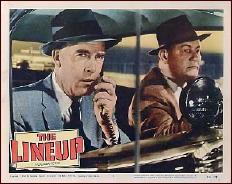
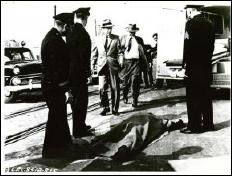
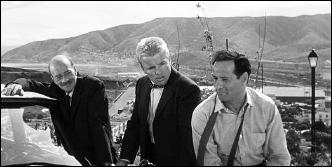
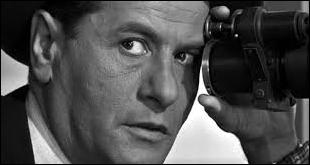
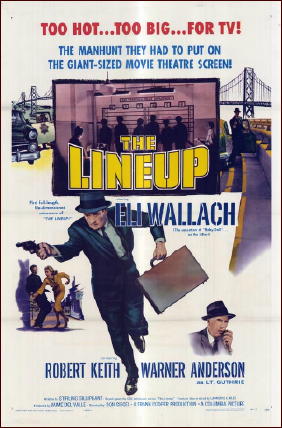
May 20th, 2014 at 3:42 pm
The series often used a similar format, as did many of the cop series of the era, spending far more time on the guest star criminal than the detectives. It’s a format little used by drama on television today where the hero’s life is a continuing soap opera, but it was pretty standard in Golden Age television, still going strong with The FBI. If I remember even the first season of Cannon used this format.
The semi anthology format with continuing characters in the background attracted some top actors and creative teams with some familiar names on both sides of the camera. It also provided a place for young actors to learn their craft including James Dean, Paul Newman, Steve McQueen, Robert Redford (Naked City, Wagon Train, Perry Mason, Twilight Zone …), and Clint Eastwood.
I agree on this film, and Wallach’s Dancer and Keith’s creepy Julian have the kind of relationship only noir had the guts to suggest. I tend to think of this one as underappreciated because of its tie to television, which is a shame considering how well it is done.
May 20th, 2014 at 4:16 pm
This is one of my favorite film noirs. This may be Robert Keith’s best role as he gleefully writes down the last words of his victims. One of the best.
May 20th, 2014 at 4:44 pm
Agreed. I think it probably is Keith’s best role as well. Can’t get much better than the deranged Julian
May 21st, 2014 at 12:10 am
Since nobody else mentioned it …
The Lineup TV series starred Warner Anderson as Lt. Guthrie and Tom Tully as Inspector Greb.
They were both supposed to carry over their roles in the movie, but the outspoken Tully took exception to the diminished role of the detectives and quit the production; hence Emile Meyer as Inspector Quine.
Tully continued with the TV series until the fall of ’59, when CBS expanded it to an hour and added a bunch of younger regulars.
Not surprisingly, Tom Tully didn’t care for the changes; he walked after the first few episodes.
AS things turned out, the audience didn’t like the new format either, and The Lineup folded in midseason.
Interesting that these days no one seems to remember The Lineup as a TV series, while the movie has at least semi-classic status.
May 21st, 2014 at 9:41 am
Thanks for all of the inside info about the TV series, Mike. I don’t remember watching the hour-long version — and in fact I hadn’t even known about it before. I have an excuse, though. In the fall of ’59 was when I went to college, and there’s a huge gap that follows in my TV watching days. I don’t remember all that much about the earlier seasons, but I did watch it. One of the interesting aspects of every episode is how they managed to work an active police lineup into every one of them.
May 21st, 2014 at 3:03 am
Interesting that Siegel returned to the theme of the two hit men as protagonists in THE KILLERS (1964) with similar results.
May 21st, 2014 at 11:36 am
The Lineup ran five years on CBS as a half-hour, starting in 1954; it was one of the first shows to syndicate its reruns while still on the network – the syndie title was San Francisco Beat.
1954 was the year that Tom Tully was Oscar-nominated for The Caine Mutiny, so getting him for a TV series was kind of a coup for CBS. This would also account for Tully’s resentment of his and Warner Anderson’s demotions in the feature.
One more point: Tom Tully apparently held no grudge against Don Siegel, appearing in a number of his films afterward; his last such appearance was in Charley Varrick, as a wheelchair-bound pawnbroker. That wasn’t a prop – Tully had lost both legs to illness, but continued to act straight through to the end of his life.
November 8th, 2017 at 2:40 am
This is nothing more than a routine 1950’s police procedural. There’s nothing special, or even good about just another shabby, old movie. Except for a few of the San Francisco outdoor shots, there’s nothing special about the cinematography.
Furthermore, it not a film noir. There’s nothing noir about it. The story and the direction are nothing more than a police crime hunt, the type of which many, many were churned out during the 1950s. There’s none of the tension found in actual noirs, nor is there any room for the kind of moral ambiguity that sets noirs apart.
Here, as in all police procedurals, things are simple. Bad guys are bad. The police chase them. Eventually, the bad guys slip up and die. The end.
Despite that, some of today’s viewers, such as some here, try to read more into them then there is in the paper-thin plots and hammed up acting. So, they insert today’s modes of behavior into the past when it wasn’t there, such as David Vineyard here plugging in “the kind of relationship only noir had the guts to suggest”.
Actually, 40’s and 50’s movies of all stripes were chock full of buddy, or teacher-mentor type situations. Those extended even into comedy, of which the Bob Hope/Bing Crosby movies are a prime example. The Line Up uses a mundane, criminal teacher-mentor plot device, but that’s enough to set today’s Vineyards a flight, injecting all sorts of deviant suggestions.
Within the confines of the artificial acting of the day, Eli Wallach’s marginally effective, but if they wanted crazy, they should’ve gone with Richard Widmark, tho he probably wasn’t available.
So, bottom line, you get a straightforward cop movie, no different from hundreds of others just like it that they spat out during the 50’s. If you like that sort of thing, knock yourself out. Otherwise, there are better films to waste time on.
November 10th, 2017 at 2:35 am
Here is a radio episode from the series:
https://www.youtube.com/watch?v=uHHtwBn_yag
Here is an episode from the TV series (aka San Francisco Beat)
https://www.youtube.com/watch?v=5iSNBFkgCAI
January 28th, 2021 at 11:55 am
[…] actor Robert Keith, who was simply brilliant as a criminal in The Lineup, which I reviewed here, portrays a settler seeking vengeance against the Modocs, while Irish-born actress Audrey Dalton […]